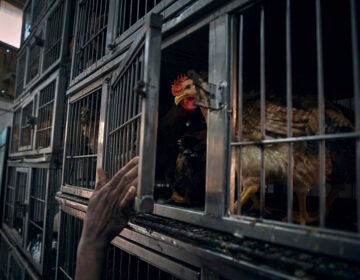Hunger is a worldwide problem that hits close to home

Chinatown in Philadelphia (Kimberly Paynter/WHYY
About a year ago I interviewed a woman who volunteers at a church-sponsored soup kitchen in Center City. The essay, “Women Who Serve,” was posted on Women’s Voices for Change, and gave me a more hopeful perspective on ending hunger. But seeing the homeless men stream through the dining area, eating with their coats on, was a reminder of one night in Chinatown, several years ago that left me feeling helpless.
This experience left an indelible mark on my soul, rubbed raw with the reality of hunger staring me in the face. Despite my volunteering efforts at MANNA, Meals on Wheels, and The Hunger Project over several years, as well as my own research on nutrition and hunger, nothing had prepared me for it. All these gestures on my part became useless comfort as I walked with my younger daughter and my son, then a student at Temple University, to dinner in Philadelphia’s Chinatown.
While looking for a restaurant, approaching an intersection, I spotted large, black, plastic bags perched on the curb; then a bare, dirty mattress with a man sleeping on it — long hair in tangles with one arm flung over his face to block out the street lights. Next to him sat a woman, shivering, sitting on one of the plastic bags. One look at her and I could see she was cold and hungry. A phrase I knew from The Hunger Project came to mind: “Life at the edge of survival.”
I tried to look away but could not. Here was in-your-face hunger, and not words on a script for helping the poor, or food packages put together in a warm and well-lit building. My son said simply, “street people,” a sadly cryptic yet apt description. “There are soup kitchens and shelters, the Salvation Army, and rescue missions,” he continued, “but there are still so many who can’t get help.”
With that picture and many unanswered questions in my head, we went to dinner. I blocked out the scene with family talk, trying to ignore my feelings. I had never lived in a large town or city where people slept in the streets, so seeing this woman and man was a reality check. (We lived in a small town in central Pennsylvania at the time.) As soon as we stepped back into the night, I thought about those hapless people hugging the gutter. I half-hoped the couple would be gone as we walked around the neighborhood and then headed back to our car. But approaching the corner again, there they were, in the exact positions as before.
Before we reached the corner, my younger daughter shrieked, “A rat, Mommy, I just saw a rat.” I was focusing on the homeless couple and missed the sighting. But my son also saw the rat and commented that it was the size of a small cat.
I shuddered and spoke up, “ What can we do for these two people?”
My son offered to call one of the rescue organizations when he returned to his room near campus. That wasn’t good enough for me. “I want to do something now! They are obviously hungry, and tonight will be cold.”
Holding tightly to my daughter’s hand, we walked to the corner. My youngest was silent and her hand became my anchor. With a temerity I never thought I had, I quietly asked the woman, who was closer to the corner than her companion, “Have you eaten today?”
She shyly answered, “Not very much.”
“I will be right back with some hot food,” I answered.
She looked up at me with sad eyes and said, “That would be nice, ma’am.”
Quickly crossing the street to a Chinese restaurant on the opposite corner, I placed my order for two portions of fish soup, spring rolls, and steamed rice. I was putting my degree in nutrition education to use: protein from the fish; veggies in the spring rolls; and carbs from the rice. With my daughter’s help, we carried the hot food back to the street couple. I realized that I was focusing on the nutrition of the meal because I wanted to block out my feelings: helplessness, sadness, and disbelief. Even my daughter kept silent, never once saying she was bored, her reaction when we did something she did not like.
I handed the woman the bags of food with a heavy heart, knowing this one meal was not a solution. Her partner, shoeless I now noticed, was still asleep on the mattress, curled in a fetal position. She looked up again and said, “Thank you, ma’am,” gently taking the bags from my arms. My hands never touched hers.
All I could manage was a simple, “You’re welcome.” I didn’t trust my voice to say anything else. Instead, I grabbed my daughter’s hand and walked away quickly, never looking back. So much emotion in my heart, but the words would not come.
What can you say to a hungry person when you are face to face? Where is the comfort when you know the curb will be her bed and the rats her companions? What words of hope can I offer when, looking into her ancient eyes, she represents the hopelessness of millions of hungry people on the planet? What words of cheer can I offer when sadness is permanently pressed onto her face?
Now, when I write out a check to an ending-hunger group, donate packaged food for a drive, or volunteer at an organization that feeds the hungry, that scene in Chinatown will come to mind.
And at the soup kitchen two years ago, I was able to smile and say hello and offer the homeless men some choices for their lunch, probably their only meal of the day. I realized, gratefully, there are places in Philadelphia that take care of people who are homeless and hungry; yet my experience in Chinatown opened my eyes to a sad reality that has never gone away.
This experience put a human face to hunger right in my own back yard. So when I forget for even one moment that more than 21,000 people worldwide each day die of hunger, and that, right here in this country and my adopted city of Philadelphia, children go to bed hungry, the face of that woman in Chinatown will be my reminder. And her humble thank-you for bringing her food is a gesture permanently pressed into my heart and mind, never to be forgotten.
WHYY is your source for fact-based, in-depth journalism and information. As a nonprofit organization, we rely on financial support from readers like you. Please give today.




